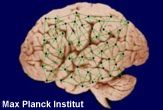Brains Not Like Computers, Study Finds

As you read this sentence, your brain is processing the letters into words. One popular theory associates this activity with a computer that inputs each bit of data – in this case letters – one after the other.
But a new study finds that language comprehension is not broken up into discrete chunks. Indeed, the brain may work in a more continuous, analog fashion – in which the yes-no, on-off, one-zero precision of the digital computer is only gradually achieved.
Michael Spivey, a psycholinguist from Cornell University, tracked mouse movements on a computer screen of 42 student volunteers. When the students heard a word, such as "candle," they were instructed to click on one of two images that corresponded to the word.
Struggling with ambiguity
When presented with images whose names did not sound alike – for instance, candle and jacket – the subjects moved the mouse in a straight line to the correct image. However, when the images had similar names – like candle and candy – the subjects took longer to click.
"When there was ambiguity, the participants briefly didn't know which picture was correct and so for several dozen milliseconds, they were in multiple states at once," Spivey said.
The evidence for "multiple states" is the fact that the mouse trajectories in the ambiguous cases were no longer straight, but curved.
If the brain worked like a computer, one might expect the students to wait until they had processed the whole word before moving. Or perhaps they would make a preliminary guess towards one image, and then correct themselves and change direction.
Sign up for the Live Science daily newsletter now
Get the world’s most fascinating discoveries delivered straight to your inbox.
But a curved line seems to indicate that the students started moving the mouse after only processing part of the word. And yet they appear to hedge their bet by staying somewhere in between the two guesses.
"The degree of curvature of the trajectory shows how much the other object is competing for their interpretation; the curve shows continuous competition," Spivey said. "[The students] sort of partially heard the word both ways, and their resolution of the ambiguity was gradual rather than discrete."
Shades of gray
Neurons in the brain may still work like electrical circuits or a computer network, but this activity may not correspond to the black and white clarity of a computer. Spivey and his collaborators are advocating a "biological" model of the brain that allows for shades of gray.
"In thinking of cognition as working as a biological organism does," Spivey said, "you do not have to be in one state or another like a computer, but can have values in between – you can be partially in one state and another, and then eventually gravitate to a unique interpretation."
This sounds a bit like Schroedinger's Cat – a paradox from quantum physics in which an unfortunate feline can be both dead and alive. So perhaps a quantum computer – whenever one of those finally gets built – will make a better analogy to the human brain.
This study was published online last week in the Proceedings of the National Academy of Sciences.










